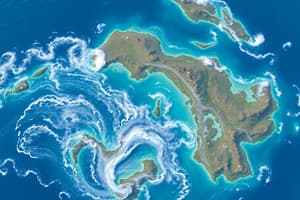Podcast
Questions and Answers
What percentage of the earth's water is held by the oceans?
What percentage of the earth's water is held by the oceans?
- 50%
- 90%
- 70%
- 98% (correct)
Which type of aquatic life zones are primarily characterized by high salinity?
Which type of aquatic life zones are primarily characterized by high salinity?
- Transitional life zones
- Estuarine life zones
- Freshwater life zones
- Marine life zones (correct)
What are aquatic life zones that support life in both freshwater and saltwater called?
What are aquatic life zones that support life in both freshwater and saltwater called?
- Transitional zones
- Aquatic reserves
- Estuarine systems (correct)
- Coastal wetlands
Which of the following substances is primarily responsible for the salinity of ocean water?
Which of the following substances is primarily responsible for the salinity of ocean water?
What portion of the earth's surface does the Pacific Ocean cover?
What portion of the earth's surface does the Pacific Ocean cover?
What is the primary way aquatic species are categorized based on their mobility?
What is the primary way aquatic species are categorized based on their mobility?
Which of the following is NOT classified as a freshwater life zone?
Which of the following is NOT classified as a freshwater life zone?
What role do ocean ecosystems play in the global water cycle?
What role do ocean ecosystems play in the global water cycle?
What characteristic makes estuaries highly productive ecosystems?
What characteristic makes estuaries highly productive ecosystems?
Which of the following is a type of marine wetland?
Which of the following is a type of marine wetland?
What is one ecosystem service provided by estuaries?
What is one ecosystem service provided by estuaries?
What role do estuaries play in storm suppression?
What role do estuaries play in storm suppression?
How does the degradation of estuaries impact commercial fishing?
How does the degradation of estuaries impact commercial fishing?
Which type of freshwater wetland is characterized by permanently flooded land and high nutrients?
Which type of freshwater wetland is characterized by permanently flooded land and high nutrients?
What is a major impact of human activities on wetland ecosystems?
What is a major impact of human activities on wetland ecosystems?
What is one economic consequence of losing ecosystem services provided by estuaries?
What is one economic consequence of losing ecosystem services provided by estuaries?
What is the primary cause of cultural eutrophication?
What is the primary cause of cultural eutrophication?
Which nutrients are most commonly associated with the process of eutrophication?
Which nutrients are most commonly associated with the process of eutrophication?
How does cultural eutrophication typically affect oxygen levels in water bodies?
How does cultural eutrophication typically affect oxygen levels in water bodies?
What are common sources of nutrients that contribute to cultural eutrophication?
What are common sources of nutrients that contribute to cultural eutrophication?
In what environments does eutrophication generally occur?
In what environments does eutrophication generally occur?
What term describes the changes that occur in a freshwater system due to an influx of nutrients?
What term describes the changes that occur in a freshwater system due to an influx of nutrients?
What happens to algal blooms after their initial growth due to nutrient influx?
What happens to algal blooms after their initial growth due to nutrient influx?
What type of lakes are most commonly classified as mesotrophic?
What type of lakes are most commonly classified as mesotrophic?
What primarily nourishes the profundal zone in a lake?
What primarily nourishes the profundal zone in a lake?
Which of the following is a factor contributing to the formation of depressions in the Earth's surface that can create lakes?
Which of the following is a factor contributing to the formation of depressions in the Earth's surface that can create lakes?
What role does the littoral zone play in a lake's ecosystem?
What role does the littoral zone play in a lake's ecosystem?
How do ecologists classify lakes?
How do ecologists classify lakes?
Which of the following is NOT a common cause of depressions that lead to lake formation?
Which of the following is NOT a common cause of depressions that lead to lake formation?
What physical feature distinguishes the limnetic zone from the littoral zone?
What physical feature distinguishes the limnetic zone from the littoral zone?
Which of the following factors is most likely to increase the nutrient content in lakes?
Which of the following factors is most likely to increase the nutrient content in lakes?
Which lake characteristic is closely related to biodiversity?
Which lake characteristic is closely related to biodiversity?
What effect does the influx of cow manure into the stream have on aquatic ecosystems?
What effect does the influx of cow manure into the stream have on aquatic ecosystems?
What is one consequence of increased turbidity in a water body?
What is one consequence of increased turbidity in a water body?
Which zone typically contains the most diverse aquatic life?
Which zone typically contains the most diverse aquatic life?
What primarily influences the death of trout in the stream?
What primarily influences the death of trout in the stream?
What role do aerobic decomposers play in the aquatic ecosystem?
What role do aerobic decomposers play in the aquatic ecosystem?
What is a likely effect of algal blooms on sunlight penetration in water?
What is a likely effect of algal blooms on sunlight penetration in water?
How does the flow rate of rivers and streams change from the source zone to the floodplain zone?
How does the flow rate of rivers and streams change from the source zone to the floodplain zone?
Why may increased turbidity affect water temperature?
Why may increased turbidity affect water temperature?
Flashcards are hidden until you start studying
Study Notes
Ocean Facts
- The Pacific Ocean is the largest, containing over half of Earth's water and covering one-third of its surface area.
- Oceans collectively account for nearly 98% of Earth's water supply.
- The global ocean is crucial for the water cycle, connecting all forms of life.
Aquatic Life Zones
- Aquatic life zones include marine (saltwater) and freshwater systems.
- Major components of marine life zones: oceans, bays, estuaries, coastal wetlands, shorelines, coral reefs, and mangrove forests.
- Freshwater life zones consist of lakes, rivers, streams, and inland wetlands.
- Estuaries, which mix saltwater and freshwater, are classified as marine systems for discussion purposes.
Organism Types
- Key organism categories in aquatic life zones:
- Plankton: Divided into phytoplankton (plant-like), zooplankton (animal-like), and ultraplankton (tiny photosynthetic organisms).
- Estuaries are highly productive, providing food sources and nurseries for fish and shellfish.
Wetlands and Ecosystem Services
- Freshwater wetlands include swamps, marshes, bogs, fens, and prairie potholes; coastal wetlands include estuaries and mangrove swamps.
- Wetlands provide crucial ecosystem services:
- Nurseries for aquatic species.
- Protection against storms by absorbing wind and wave energy.
- Human activities have significantly affected both freshwater and marine wetlands.
Lake Zones
- Lakes are categorized by nutrient content:
- Eutrophic lakes have high nutrient levels, leading to high primary productivity.
- Mesotrophic lakes lie between eutrophic and oligotrophic (lower nutrient levels).
- Deep lakes contain distinct life zones:
- Littoral Zone: Shallow, sunlit area with high biodiversity.
- Limnetic Zone: Open water area supporting plankton and fish.
- Profundal Zone: Deeper, dark area reliant on organic matter for nutrients.
Eutrophication
- Eutrophication is the process where water bodies experience nutrient overload, leading to algal blooms.
- Cultural eutrophication occurs due to human activities adding excessive nutrients (nitrates, phosphates) from fertilizers, sewage, and runoff.
- Algal blooms block sunlight, leading to aquatic plant death and deoxygenation, which affects fish like trout.
River and Stream Dynamics
- Rivers and streams are classified into three distinct zones:
- Source Zone: Narrow, cold, clear waters with high oxygen content, housing algae and mosses.
- Transition Zone: Wider, warmer streams that carry sediments and nutrients.
- Floodplain Zone: Further downstream, features rich ecosystems subjected to seasonal flooding.
Human Impact on Aquatic Ecosystems
- Nutrient pollution from agricultural runoff can lead to significant ecological challenges in freshwater systems, like decreased fish populations due to lowered oxygen levels.
- Alterations to wetlands can impact local fisheries, reducing commercial yield and elevating economic costs from storm damage.
Conclusion
- Aquatic ecosystems play essential roles in biodiversity, climate regulation, and human economies.
- Protecting and restoring these ecosystems is critical for sustaining environmental health and human livelihoods.
Studying That Suits You
Use AI to generate personalized quizzes and flashcards to suit your learning preferences.



